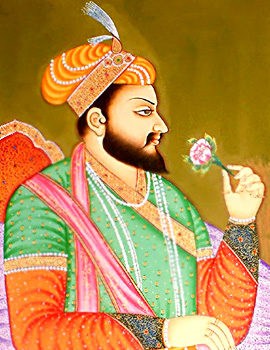 Christianity during Shah Jahan`s reign did not get much favour from the Emperor as was very Orthodox in his religious views. Christianity was quite a new religion at this point in time and its religious influence was just making headway at this point in time. For the Mughals, European products were exotic, and they all built up collections of European curios, as their Western counterparts did of oriental exotica. Many of the items were religious relics presented by missionaries. The Mughals had no religious issues about these artistic works and treasured them for their artistic value. The Mughals must have had a genuine appreciation of their aesthetic quality, since there is much similarity in technique between the stylized pre-renaissance icons and Mughal Miniature Painting. However, where the religion of Christianity was concerned they had rather strong objections to the spread of the religion in the country. Shah Jahan, particularly, was one of those Mughal Emperors who were completely against the religion. The Portuguese came to trade, but, being staunch Catholics, they also brought missionaries. It was not until they captured the port of Goa from the Sultan of Bijapur in 1515 and reports began coming in that they were forcibly converting the locals and subjecting those that resisted to Inquisition-like trials. When such conversions started taking place, it became a cause of concern for the Mughals.
Christianity during Shah Jahan`s reign did not get much favour from the Emperor as was very Orthodox in his religious views. Christianity was quite a new religion at this point in time and its religious influence was just making headway at this point in time. For the Mughals, European products were exotic, and they all built up collections of European curios, as their Western counterparts did of oriental exotica. Many of the items were religious relics presented by missionaries. The Mughals had no religious issues about these artistic works and treasured them for their artistic value. The Mughals must have had a genuine appreciation of their aesthetic quality, since there is much similarity in technique between the stylized pre-renaissance icons and Mughal Miniature Painting. However, where the religion of Christianity was concerned they had rather strong objections to the spread of the religion in the country. Shah Jahan, particularly, was one of those Mughal Emperors who were completely against the religion. The Portuguese came to trade, but, being staunch Catholics, they also brought missionaries. It was not until they captured the port of Goa from the Sultan of Bijapur in 1515 and reports began coming in that they were forcibly converting the locals and subjecting those that resisted to Inquisition-like trials. When such conversions started taking place, it became a cause of concern for the Mughals.
Shah Jahan`s relationship with the Christians was always bitter. In 1630, Shah Jahan decided to destroy the Portuguese colony at Hugli, in Bengal. He bore a grudge against them because they had refused to assist him earlier when he rebelled against Jahangir, but there were also reports of atrocities being committed on the local villagers. What finally incensed the Emperor was the incident when Portuguese pirates kidnapped two of Mumtaz Mahal`s slaves. Hugli had become a haven for slave merchants and pirates who kidnapped the local inhabitants and sold them, so the Emperor ordered the Governor of Bengal, Qasim Khan, to destroy the colony. Some managed to escape after the city surrendered, but the rest, several thousand in number, mainly women and children, were taken prisoner and sent to Agra. Many died during the seven-month journey. Shah Jahan freed those of the men who converted, and those who did not were condemned to be whipped or imprisoned. The women and children were distributed among the harems of the nobles. This broke the Portuguese monopoly on trade with India, and the way was clear for other Europeans to move in.
Thus during Shah Jahan`s reign, the Christian missionaries in Agra were living in a hostile environment and following their calling very discreetly. The Emperor did not hide his animosity towards them. However, Shah Jahan`s son Dara Shikoh had a much more tolerant and even benevolent attitude towards the Christians. He counted Jesuits among his intimate friends. They included Henri Uwens, known as Father Busee, (1618-87), who established himself in Agra where he led a mission; another member of the Company of Jesus, Pedro Juzarte; and a Neapolitan, Father Stanislas Malpiqua, General of the Jesuits in Goa. However, this Prince tended to overdo his iconoclasticism. His outspoken, irreverent views often offended not only the orthodox, but also the more urbane Muslim courtiers, and there were even occasions when he annoyed his doting father.
The attitude of his son notwithstanding, Shah Jahan had rather strong reservations against the spread of Christianity in his kingdom and did everything possible to quell the works of the traders and missionaries.






































